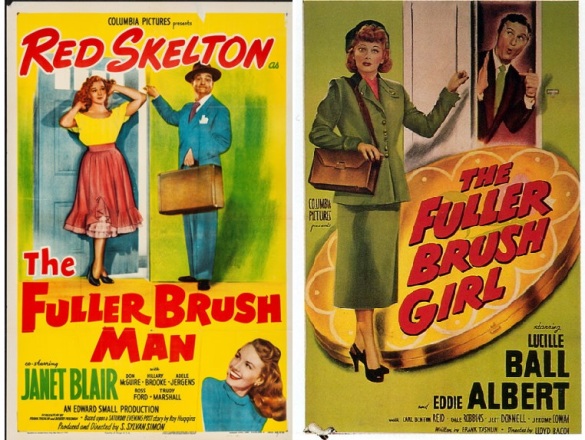
The Fuller Brush Man—now there’s a dated catchphrase. For those baffled young uns’ out there, this was a guy selling Fuller brushes door to door (Fuller was the name of the company founder, not a description of the brush itself). Door-to-door selling takes some enterprise and energy to do, plus a Never-Say-Die spirit to make that sale. It’s not a job I’d want. One door slam and I’m out.
Being that Fuller brushing, as well as door-to-door selling, was something of a mid-twentieth-century cultural commonplace (Death of a Salesman, anyone?), a movie was made about it—The Fuller Brush Man from 1948. Which is about a guy attempting to become one such salesman. Among other things, that is; there’s only so much plot interest brush selling can drum up. The film quickly switches to a murder mystery, throwing in a couple of corpses and a criminal gang, which have nothing to do with brushes or sales or trudging door-to-door, but which I assume were inserted to keep audiences happy. I wonder if it gave viewers a false view of a salesman’s job—Thrills! Chills! Excitement behind every door! Face-to-face salesmanship may be a peculiarly American phenomenon, arising from our self-image of the American dream to Make It Big. Unlike plays by Arthur Miller and David Mamet, though, which examine the hollowness of such dreams, FBM looks at the lighter side of salesmanship, poking fun at get-up-and-go sales techniques and customer resistance to such. Until it changes the subject and decides to look at something else.
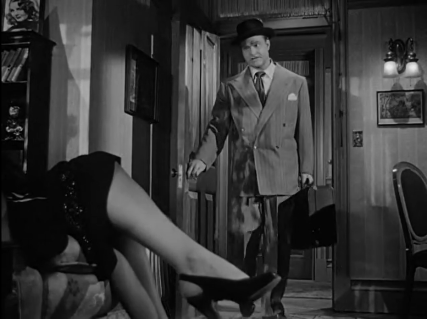
The movie stars Red Skelton as the title character, trying to make good at his job and failing (epically), but still coming out on top; and many of the jokes revolve around one’s tolerance for Red. I rather like Skelton, but he did try me here. A routine where he mimes a woman applying make-up is cringy—just a Big NO. Skelton lacked delicacy in his mugging, he’s obvious and overreaching, and his humor quickly pales. Red was also hitting middle-age spread by now, and his face, as with his body, was also spreading. His cheeks are soft and flabby, oddly like an infant’s; he looks like a Cabbage Patch doll gone to seed. And he had the oddest bite (in mouth and teeth) I’ve seen, his front top teeth looking shorter than the back ones. Which also makes him look infantile. Whatever meanings his face conveyed to audiences of the era, romance wasn’t one of them.
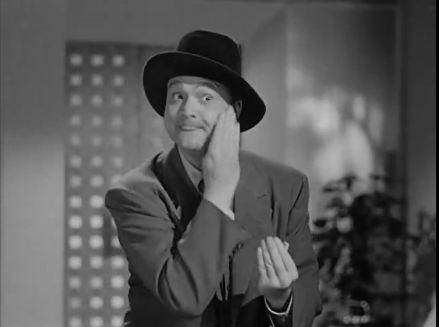
That may be the most wearying aspect of Skelton: He had zero sex appeal onscreen. Red played the perpetual man-boy in his films, naïve, unworldly, unsexual, childlike, never wising up, to the point of irritation (his girlfriend in this film snaps at him to grow up). If he yearns romantically, he looks not like an adult but like a small boy with a crush on the teacher, tilting his head and gazing goofily. Much of that persona rests in that soft, rubbery face, not an amorous face, more like Silly Putty stretched out of shape. Yet Skelton was always paired with a beautiful girl (here, gorgeous Janet Blair), and it’s not convincing. Why would a beautiful woman find this Aging Widdle Kid attractive? Why not have cast him with an actress of average looks, who, though less beautiful, would look more convincing with him?
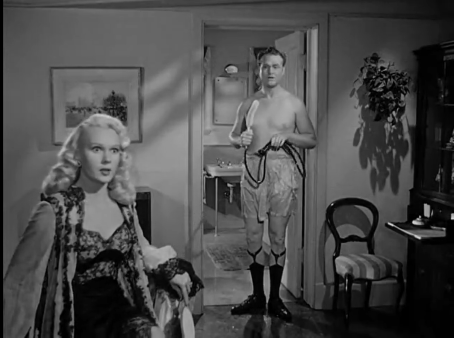
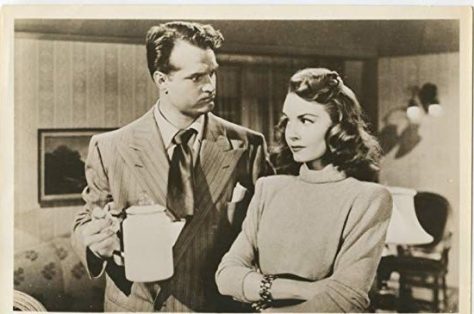
Ah, well, that’s Hollywood: Beauty and the Boob. The Child Man was a constant of film comedy (Harry Langdon, Stan Laurel, for starters), but it needn’t have been—hadn’t anyone in Hollywood ever seen the great Max Linder? Skelton, though, had to work with the physical equipment he had, which did include a surprisingly graceful physical agility (Buster Keaton was a frequent coach). That big, thick body of his assumes a lovely lightness in a pratfall; he seems pulled down not by gravity but by the ground slyly slipping from under him. That ability works well in FBM, which was co-written by Frank Tashlin, and which, like many of this ex-animator’s films, seems more like a cartoon than real life. Note the construction of a typical gag: Red races offscreen, pursued by a cop; there’s the sound of an offscreen crash; then a car drives into the frame, with Red plastered along hood and windshield—and his boss just happens to be inside. Change Red to Wile E. Coyote, add a big, vibrating puff of smoke when the crash happens, and we know where we are.
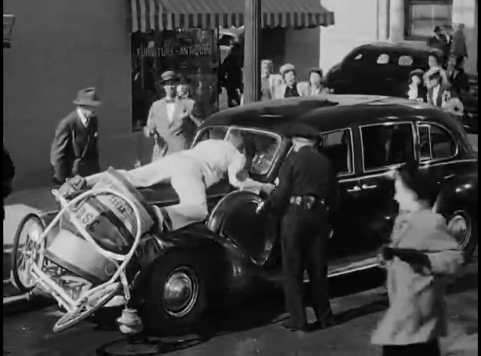
I’ll credit Tashlin for the film’s witty credit sequence, a series of brief scenes depicting, to the music of the song “Stout-hearted Men,” a salesman’s job tribulations, including barking dogs, bangs on the head, and rain; that you only ever see, as visual metonymy, the salesman’s legs and hands makes it funnier. There are other good things, such as a running gag of an ironing board falling out of a cupboard and bonking someone on the head every time a kitchen door is closed (well-timed and funnier than it sounds), as well as a routine of a small, nasty boy who steals Red’s brushes and shoes (apparently derived from Skelton’s Mean Widdle Kid radio character). There’s something deeply, subversively satisfying in watching rude, unsentimental depictions of child behavior; and I’ve no doubt that real widdle kids (as well as some of us older ones) prefer watching such rampaging tots to weepy Margaret O’Brien types.
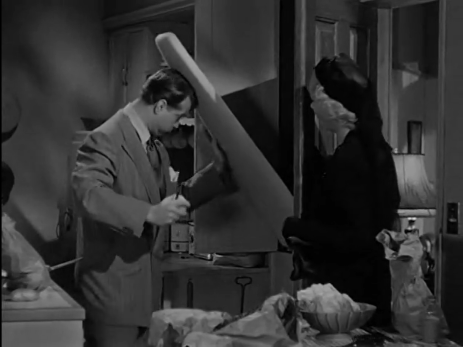
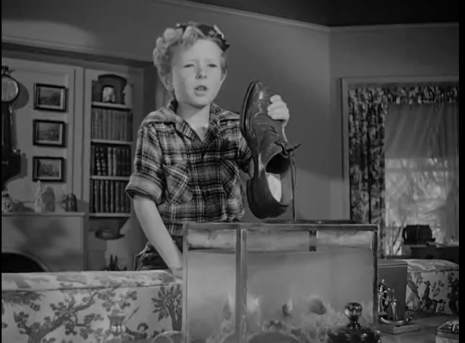
Otherwise, the film’s not so much a story but a string of jokey situations, first of Red trying to sell Fuller brushes, then of Red trying to catch criminals. It culminates in a 20-minute set piece, of Skelton and Blair being chased by the bad guys in a war-surplus warehouse, the pair using everything at hand—helmets, nets, inflatable dinghys, even modular walls—for a laugh. I bet Tashlin’s idea was of an enclosed space with lots of bizarre gag props for Skelton to play with, and then he let it riff. The sequence goes on too long, and not all the gags work, but it’s frenetic enough to hold fraying attention spans, both widdle and not-so-widdle.
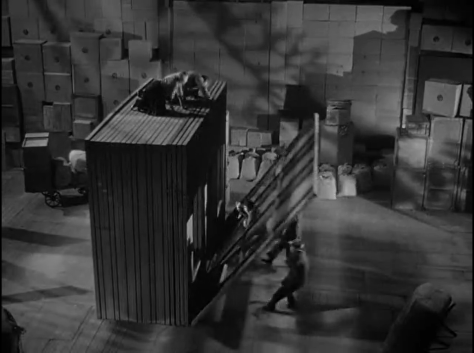
FBM was a hit, big enough for its studio (Columbia) to make a 1950 follow-up, The Fuller Brush Girl, starring Lucille Ball. Tashlin again wrote the script (singly, this time), and he used a similar plot and gags, including opening scenes of the intrepid FBG on the job—encountering more dogs, slammed doors, a lost shoe heel, and water poured from a window (and to the same tune!), as well as a slam-bang finish with the FBG and her boyfriend hiding from criminals in another enclosed space (an ocean liner filled with bananas, barrels, wine casks, and a pair of chattering parrots). As with the first film, the second piles on as many screw-ups as the saleslady, this time selling cosmetics, can get into, one involving a hair perm kit that, due to convoluted circumstances, removes the hair instead of setting it. It’s “gonna come out just fine,” assures the saleslady, and unfortunately it does—come out, that is. Scenes of bobby-pinned curls dropping as the gentle rain from the scalp upon the wall-to-wall carpeting beneath are grotesquely funny (it’s very Tashlin), making you both giggle and squirm. Skelton also makes an appearance, selling the FBG a pair of brushes, as does the marvelous Mary Treen, who sells her a magazine subscription. Was EVERYONE selling after the war?
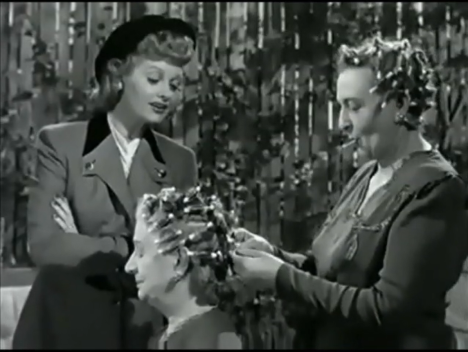
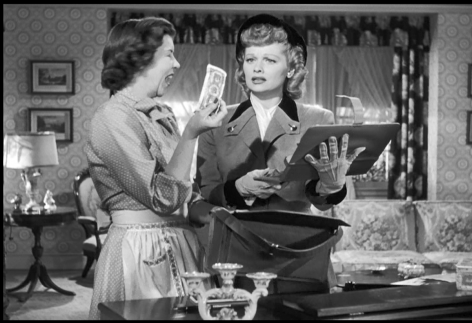
Tashlin had previously written a film for Lucille Ball (Miss Grant Takes Richmond), and no doubt was familiar with her superb comic abilities; Ball was as talented a physical comedian as Skelton, and a helluva lot sexier. Maybe that’s why FBG and Tashlin slipped her a strip-tease number. The first film was as wholesome as dish soap—Red notes he met his girlfriend at church—and Skelton himself always insisted on clean humor. But Tashlin was known for outrageous innuendo (check all those barenaked ladies in Who’s Minding The Store, which I wrote about here), and may now have felt freer to flaunt his kind of fun. A sight gag, for instance, of a leaky water cooler, its liquid streaming out a window in a suggestively graceful arc—that’s a joke that could only be Tashlin.

However, the strip-tease number is pure Ball. It starts with Lucy hiding in a burlesque house (too many plot complications to explain briefly) and being mistaken for a substitute artiste (her glued-on disguise of three-inch-long eyelashes, plus a mouth lipsticked to the nostrils, add to the confusion). Chased by two thugs, Lucy runs onto the stage, bouncing between the wings (one thug in each), losing an item of clothing at each bounce. Faced with a laughing audience or menacing hoods, Lucy chooses guffaws over goons and goes into her dance—slithering a scarf round her torso, she wiggles her bottom and waggles her head, while popping her eyes like hyperthyroid ping-pong balls as she bumps and grinds her way to glory. “That’s not work,” says one film character, “that’s real talent!” It sure was. I waffed like a widdle kid every time I watched.

BONUS CLIP 1: “Wanna buy a brush?” Red Skelton demonstrates his selling and detection techniques in what’s listed as a ‘faux’ trailer for The Fuller Brush Man:
BONUS CLIP 2: And here’s the re-issued trailer for The Fuller Brush Girl, containing a snippet of “Put The Blame On Mame” from Gilda—not too surprising as both films were produced by the same studio:
BONUS CLIP 3: And for those completists out there, here’s a late 1950s promo film for the actual Fuller Brush Company (which still exists and now sells products via the Internet…):





Patricia Nolan-Hall (@CaftanWoman)
/ February 10, 2020The Tashlin sensibility appeals to me. Although, I agree that there’s too much of a good thing in some of those set pieces.
The last time I saw the “real” Red was on a Canadian talk show, The Dini Petty Show. He was the only guest and I was curious but anxious. He’s an old guy. Is he going to do that old guy rambling thing? It almost appeared so at the start, but by the end of the episode, Red had that entire audience laughing and eating out of his hand. It was terrific.
Grand Old Movies
/ February 10, 2020I remember watching his TV show (I’m old enough!) and finding it very funny. Skelton could be VERY funny in his films, but somehow the Innocent Little Boy persona he assumed didn’t quite fit him.
Tashlin I find hit or miss; when he’s good, he’s hilarious. He seems to have been erratic in his career, but had flashes of brilliance – I think the Breen-era Hollywood in which he worked was too stodgy for him.
Patricia Nolan-Hall (@CaftanWoman)
/ February 14, 2020The Red Skelton Show was the first thing I saw on our brand new colour television. It used to tick my dad off when Red would laugh at his own jokes, but nonetheless it was regular viewing.
Grand Old Movies
/ February 14, 2020I recall watching the show, too, when I was little – even then, I thought he had a goofy looking face!